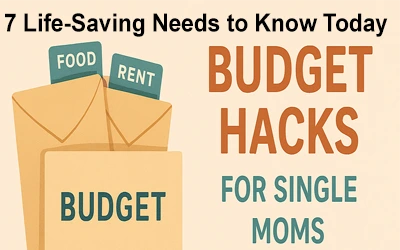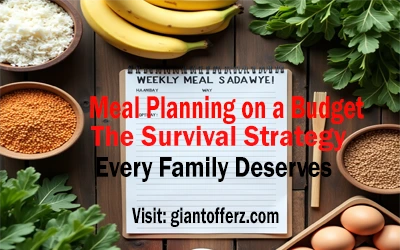
Grocery Shopping on a Tight Budget – Smart Ways to Feed Your Family for Less
Grocery Shopping on a Tight Budget – The Unspoken Battle We All Fight
Ever found yourself frozen in the middle of the grocery aisle, calculator in hand, heart sinking with every price tag? You’re not alone.
Grocery Shopping on a Tight Budget, isn’t just about making smart choices — it’s about surviving the quiet stress that builds every time you step into that store. Do you grab the milk… or skip it for now? Can you afford the protein, or will it be canned beans again this week?
Everyone loves to shout tips like “plan your meals” or “use discount apps,” but what about the emotional load? The deep sigh you hide when your cart feels too light, and your wallet even lighter.
This isn’t one of those polished posts filled with recycled advice. This is a real conversation. About what families actually face when grocery shopping on a tight budget — and the step-by-step ways to make it not just doable, but bearable.
Best Ways to Cut Grocery Costs
It’s Not Just Groceries — It’s Guilt, Stress, and Survival
Look, no one teaches you how to feed a family when you’re broke. You figure it out as you go. Sometimes that means skipping meals yourself so the kids get full plates. Sometimes it’s choosing between toilet paper and sandwich bread.
That’s not budgeting. That’s survival.
And survival has a price: emotional burnout. You end up walking into the store already exhausted. One small “treat” in the cart feels like failure, but leaving it out feels like you’re depriving your kids again.
This is the reality for thousands of families — and most advice out there doesn’t touch this side of the struggle.
Why Your Brain Works Against Your Budget
Here’s something you probably haven’t heard: when your brain feels deprived, it craves reward. That’s why, even if you come in with a strict list, you end up tossing in cookies or brand-name chips “just this once.”
It’s not weakness. It’s wiring.
The trick is to flip your mindset. Instead of thinking, “I can’t afford this,” try telling yourself, “I’m choosing what matters most.”
That small shift isn’t magic — but it gives you control back. And when everything else feels out of control, that’s a powerful thing.
The “Starter Pantry” Reset – Only $25 Can Make a Week’s Difference
You don’t need to overhaul your whole kitchen. You just need the right basics.
Here’s a budget reset method that works for struggling families:
- Pick 5 core items: things like oats, rice, pasta, canned beans, and frozen mixed veggies.
- Spend no more than $25 — shop store brands only.
- Use those basics as your building blocks for every meal that week.
You’re not trying to cook restaurant-level dishes. You’re trying to make food stretch. These ingredients can turn into stir fries, soups, casseroles — and they last.
You’ll be shocked how far $25 can go when you’re not chasing random recipes from Pinterest.
Walk in with a Plan, Not Just a List
Ever notice how you go in for 5 things and come out with 15?
That’s not bad math — it’s by design. Grocery stores are built to break your budget. From shelf placement to store music, it’s all meant to make you spend just a bit more.
So here’s how to outsmart them:
- Don’t shop hungry — sounds simple, but it works
- Wear headphones — tune out store music, stay focused
- Follow a floor plan — start at the back, stick to the outer aisles
Also, skip the middle shelves. Cheaper options live on the bottom or top. Eye-level is where the high-profit items live.
Knowing this helps you dodge those “how did I spend so much?” moments.
Money Saving Grocery Tips
Build Mix-and-Match Meals That Actually Last the Week
Meal planning doesn’t have to be complicated. In fact, the simpler, the better.
Try this flexible approach that keeps both cost and stress low:
- Pick 2 carbs: rice, potatoes, or pasta
- Choose 3 proteins: think eggs, lentils, canned tuna, or marked-down chicken
- Grab 4 veggies: go for in-season or frozen bags
- Create 6 meals by rotating those ingredients
Example?
- Rice + lentils + carrots = stew
- Pasta + eggs + spinach = skillet meal
- Potatoes + tuna + frozen peas = mash bowl
This method isn’t fancy, but it fills bellies, stretches money, and keeps variety going without wasting anything.
Don’t Buy These — Even If They Look Cheap
Sometimes, the stuff that seems cheap is secretly draining your budget.
Avoid these silent budget-busters:
- Pre-cut fruits or salad kits – you’re paying for packaging
- Single-serving snacks – buy bulk and portion at home
- Flavored yogurt and cereal – plain versions + fruit/honey = healthier & cheaper
- Bottled drinks or juice – buy powder or use water enhancers instead
Think long-game. It might feel easier to grab the ready-made stuff, but prepping at home takes a few minutes and saves hundreds over the month.
Turn Your Receipts into Grocery Money (Seriously)
You’re already spending money. Why not get some back?
Apps like Fetch, Ibotta, and Shopkick let you scan receipts or watch short videos and slowly earn points. It takes time, yes — but if you stick with it, those points turn into gift cards for groceries, gas, or Amazon.
You can also refer friends and earn $5 to $10 per signup. That’s not nothing.
If you’re shopping anyway, let those receipts work for you. You might even cover an entire week’s grocery bill over time.
Bonus: Small Habits That Stack Up
Want to quietly cut $50–$100 a month without feeling like you’re constantly sacrificing?
Try adding a few of these:
- Drink more water – cuts down soda, juice, and milk costs
- Meatless Mondays – swap meat for lentils once a week
- Leftover Friday – clear the fridge and eat what’s already there
- No-snack zones – keep snacks out of reach from little hands
These small changes don’t feel like punishment — but they absolutely impact your total spend.
Grocery Shopping on a Tight Budget
People Aslo Asked
Q. What is the best thing to do to spend less money on groceries?
Answer: Look brother, I say—write down what you need on paper in advance. Otherwise, you will keep going to the shop and buying this and that, and in the end, your budget will be overturned. Instead of rushing to buy something, think first—what you have at home, how much you can make with what. And no, it means buying a less expensive brand, and doing a little calculation—that’s it.
Q. Which foods actually fill your stomach at the lowest cost?
Answer: Hey brother, you know that pulses and rice are still the best budget foods. Along with eggs and potatoes—these are also cheap and fill the stomach. Now many people say—frozen food is bad, but it’s not. Many times, those are the cheapest and always available. Even if it’s difficult, you have to go, so these are the hope.
Q. Going to the market and getting emotional and spending more, how can you prevent that?
Answer: This thing is a battle with yourself. When you’re tired or upset, you want to buy a lot of things. Do you know what I do? I don’t go to the market on an empty stomach. I make a list, and when I go beyond that, I ask myself—”Is it okay if I don’t take this?” Most of the time the answer is, I’ll go.
Q. Is frozen food actually tastier and healthier?
Answer: See, I used to think—frozen means bad. But no, brother, frozen vegetables are often better than fresh. They are also cheaper, and they don’t spoil quickly. Just eating frozen ready-made ones won’t do—buy plain vegetables or fruits, that’s when you’ll benefit. Live, and go.
Q. How much should a small family budget for a weekly market?
Answer: This varies from place to place. But generally speaking, if you have a family of 4, you can run a market for 5-7 thousand taka a week if you do a little calculation. If you skip premium brands, shop a little cheaper. And if you buy some things once every two weeks, that’s also a good deal.
Q. Which store is better to shop at if you have a low budget?
Answer: Brother, sometimes dollar stores or LDs are better. You can get low prices and many good quality things. Also, if you go to the local farmers market at the end of the day, you can get cheap perishable vegetables and fruits. But you have to understand the offer in big supermarkets, it is better to check the circular on your mobile seven days in advance.
Q. How is it possible to eat healthy food if you have poverty or low income?
Answer: In my opinion, healthy does not mean expensive. You can get a lot of nutrition with pulses, rice, eggs and frozen vegetables. If you exclude junk food or fast food, the cost is reduced. The rest of the way is easy if you learn to cook yourself. The trick is to eat straight without adding too much spice.
Q. What are some examples of cheap but healthy meals for a small family?
Answer: You can get dal-rice, potato fry, egg roast, pulao, dal soup at an ultra cheap price. It is good to keep carrots, cabbage, sweet pumpkin as vegetables at home. These are easy to cook, quite filling, and also cheap.
Q. What is the way to reduce purchases outside the budget while shopping at the market?
Answer: Let me tell you one thing, if you take cash and use that money, it will be extra if you give a card. And you should make a list before entering the store. It is important not to suddenly go around and buy other things. Try to get there quickly when you go to a big market.
Q. How long in advance is it best to make a list for the market in a week?
Answer: I usually make a list once at the beginning of the week. Then update it a little in the middle of the week. This way, everything seems to be fine, and I am not interested in buying anything else. Going without a list is the opposite of budget.
Grocery Shopping on a Tight Budget
You're Not Failing — You're Fighting
Let’s be real.
If you’re reading this, chances are you’ve had to say “not this month” to your kids more than you’d like. You’ve stared at your cart and done the math three times, hoping for a miracle.
That’s not failure.
That’s strength in motion.
Every choice you make — every dollar you save — is another step toward stability. And while it may not feel like it now, this season will pass. You’re doing what you can with what you have, and that’s more than enough.
Want a Bit More Help?
- Download our free printable weekly meal planner based on this system — includes $500 & $700 versions for any budget.
- Or check out our guide on “How to Earn Grocery Gift Cards with Just Your Phone” — 100% beginner friendly.
You’re not alone in this. And you don’t have to do it all at once.



